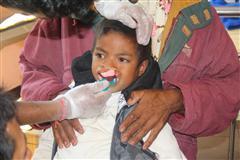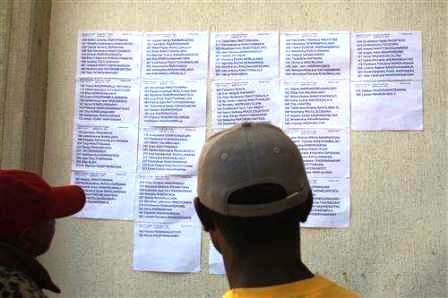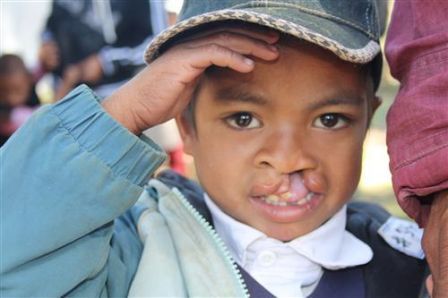The teenage boy had a distorted mouth – a cleft lip and palate. Operation Smile had selected him for surgery.
“What difference will this make to your life?” he was asked.
“After this,” he said. “I will be a man, because I will be able to blow on the fire.”
That’s an anecdote out of Rwanda, told by the co-ordinator of the Operation Smile mission currently underway. This one is to Madagascar. We were at a reception at the SA ambassador’s residence in Antananarivo, and the ambassador had just told a story about meeting a very beautiful girl, one of the earlier beneficiaries of Malagasy Operation Smile missions.
“She is a young woman who can now be kissed,” he said.
This says both everything about the power of Operation Smile, and nothing. Because, naturally, a cleft lip and/or palate can be grotesque, and make you absolutely unkissable. But that’s almost the least of your problems. The deformity also affects your ability to eat, and to breathe, and to live a life where you’re not treated as a gargoyle at best, and – at worst – as cursed.
Watching the Operation Smile operation is watching an exercise in slickness. As people throng to the hospital on the first weekend, they find a long stream of tables manned by the local Lions Club, who take comprehensive details from candidate patients (or, most usually, the adult who brought them). Then they’ll enter the hospital and climb the stairs, past oncology, past general surgery, to the ward that’s been taken over by Operation Smile. There they are photographed and screened by a dental team and by the surgeons and nurses, in order to decide who are good candidates for surgery. Moulds are taken of their mouths for those who need special palate plates called obturators, and blood work is done.

Little patient #377, Miminirina Rakotoasimbola, sitting on his father's lap, stoically looks past the moment as the dental mould hardens in his mouth.
For many of these little patients, white people are frightening. Having blood taken hurts; having a dental tray of nasty-tasting pink plaster filling your mouth and pushing up into your nose is frightening even when you’re me, even in the nice and known dentist’s chair at home. But for these kids, the whole experience - in spite of the kindness, in spite of the smiles, in spite of the juice that washes away nasty tastes and bad feelings - is frightening.
I’m not sure good intentions are always thoughtful. In photography, for instance, one of the girls has pink fluffy bunny ears on her head, and Kermit the frog wrapped around her neck. I’m sure it would amuse kids used to the Easter Bunny and Cartoon Network. But as one of my colleagues pointed out (I am one of several journalists sponsored on this mission by Elizabeth Arden), one wonders how super-frightening she might be to the kids who have never seen a white person, never mind one with four ears and strange big-eyed green growths on their necks. Are bunny ears and frogs are on some visceral level ‘normalising’ to small children? Somehow, I don’t think so.
The parents make it so much easier. There’s a calm sweetness that’s really wonderful to be around. Often, it’s dads and uncles and big brothers bringing the toddlers through, and the children here, even these deformed little ones, have an air of being deeply loved. They are as cute as buttons.
The screening divides them according to greatest need and greatest chance of success. Anyone who only has a cleft lip, is a Priority 1. All of them will be chosen for surgery. Anyone who has a cleft lip and palate and is under the age of four, is a Priority 2; and the goal is to get to all of them as well.
At the end of two days’ screening comes the heartbreaking part: everyone gathers in the semi-shade provided by some old trees in the gardens of the hospital, and the list of those who’ve been selected for surgery is read out. Those who weren’t Priority 1 or 2 have little chance of making it onto the list, and for many, it’s a bitter blow.

Family members scan the list to see who else is lucky.
David Grier, the Miles for Smiles guy (famous for running the Great Wall of China, and a smile around the tip of Africa) tells how would-be patients walk for hours, sometimes days, to get to the hospital when word goes out that Operation Smile is coming.
He has a deeper understanding than most of what this modest but powerful operation brings to the lives of those who benefit from it: his most recent adventure involved kayaking from Mozambique to Madagascar (about 500km), then running the length of the island, from the southernmost tip to the top, a distance of about 2,700km. For some of that distance he was seconded by fellow adventurer and photographer Nick. The journey was positively Livingstonian – it’s not the sort of thing that ought to be happening today. Bilharzia, the nasty haemorrhagic dengue fever, infections from where the holes left by bloodsucking leeches had admitted unnamed bacteria… both were at times almost delirious with fever.
The money raised from that run is what pays for many of the operations that will be taking place over the next four days. And during that run, he was dependent to some extent on the basic humanity of the Madagascans who today are sitting anxiously in the shade, some of whom will go home disappointed.
It’s been a heartbreaking, heartwarming exercise getting to this point. Today, as I write, the first patients are going into pre-op, and surgery is about to start.
It's very emotional.

But my favourite, stoic little Miminirina Rakotoasimbola, made the list!




 Publications
Publications
 Partners
Partners









